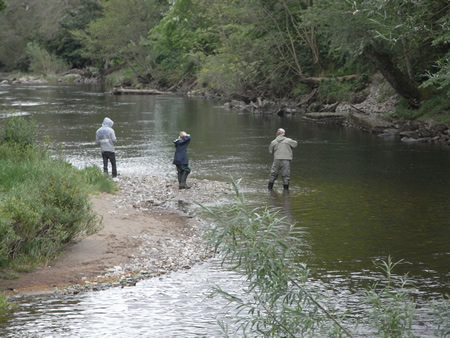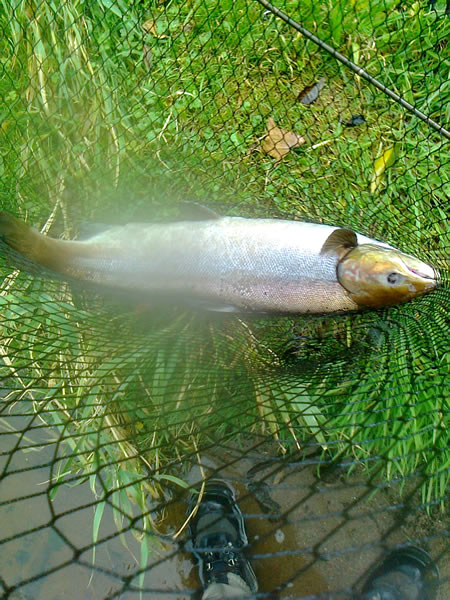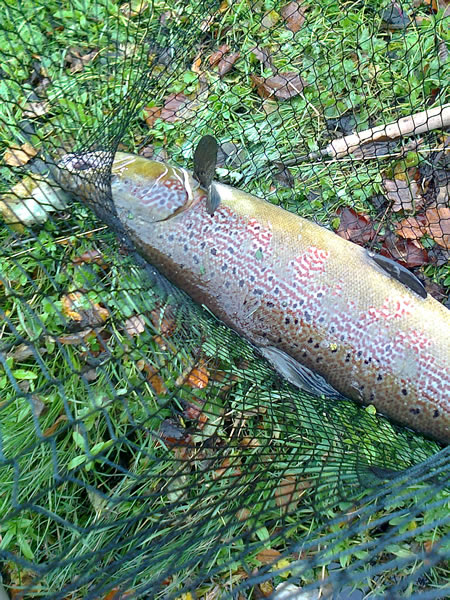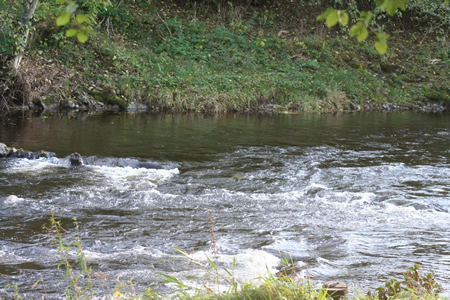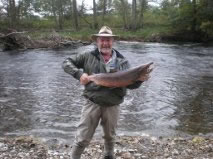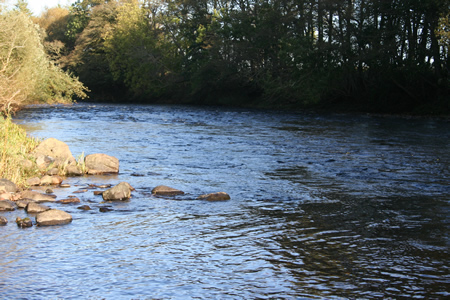These bulletin blogs represent news about Finavon and the South Esk, and my views as a riparian owner. They are not the views of any other organisation, nor are they designed to promote the interests of any individual or organisation other than Finavon Castle Water and factors affecting the fishery. Tony Andrews
The weather has never relented. There was talk of an Indian Summer and that lasted for less than a week. Then came rain, gales, but no frosts. The leaves have been forcefully removed from the trees by the wind, as opposed to being nipped off by the frosts. Amongst all of this the autumn run of salmon has been poor with most of the fish seen being MSW ‘old stagers’, and some very big fish among them. The sea trout appear to have all moved upriver and in the last three days the occasional fresh grilse has arrived at FCW. My nephew Charlie caught a 1lb 4oz fresh grilse yesterday with the appearance more of a bootstrap than Salmo Salar. As I write this bulletin early in the morning on 27/10 I note that the season’s catch at FCW is 136 salmon and 101 sea trout. We may catch a few more fish in the last three days of the 2011 season, with the catches of both salmon and sea trout almost certainly slightly below average.
This is the Red Brae looking downstream through Kirkinn to Pheasantry. The Red Brae and Kirkinn are really one pool and offer the salmon fisherman at least an hour and a half of great fishing, especially when the water level is lipping the lowest point in the Red Brae Wall.
SOUTH ESK MEETING ON 27th OCTOBER. Tonight there will be a public meeting in Brechin to discuss the Minister’s response to the Esk Board’s request to compel the nets to refrain from fishing in May. I hope this event will be a measured debate with the benefits to the salmon of the South Esk in mind, rather than a polarised and unstructured rant against the government and the netsmen. I have reflected in a previous bulletin on the Minister’s decision, and concluded that there appears to be a commitment by Government to establishing the South Esk as a model of good management for all Scottish salmon rivers. With the South Esk’s proximity to the Montrose office of Marine Scotland Science, and the availability of scientists to work on the river whose estuary is yards away from where they work, we have an opportunity to progress the much needed research on the composition of the South Esk’s salmon stock.
That plan makes a lot of sense, especially with the initial project of establishing where S Esk early running salmon go, which involves a £150,000 radio tracking project (in Year one: to be repeated in Year two) to insert radio tags into salmon caught in the nets at Usan, which will be specially deployed for the purpose. These salmon will be tracked by radio receivers at strategic points on the river from the estuary to the glens. Once we know where these spring salmon go we can assess the quality of the spawning and juvenile habitat to see if we have problems in the catchment. If they are issues we can then take action. However it is important that everyone understands that there will be no killing of fish for commercial purposes between 16 February and 30 April. The possibility of a licence being issued for the Usan nets to fish in September is only to ensure that the Usan nets are open to MSS scientists throughout the whole season. The licence can be revoked at any time and is not a permanent feature of the season as it could be if there were a regulation in place.
I hope there may be some kindred spirits in the audience with similar views to mine – that we now need to get on with the job of understanding the South Esk’s migratory fish populations. The scientists of Marine Scotland have my full support.
LATER. Well, we had the meeting and the hawks had their say, as did the voices of reason. Fortunately, the prospect of confrontation with the government and netsmen seems to have receded with the option of a judicial review of the Minister’s decision kicked into the long grass and, despite the threat of “going to Brussels” being voiced, I had the feeling that good sense would ultimately prevail. “Going to Brussels” is an empty threat and serves only to irritate officials and politicians at a time when co-operation is desperately needed and in the best interests of the river. No government minister would make such a decision in today’s EU without doing his homework first.
In fact there was a good debate, well chaired by Hughie C-A, and the more extreme views became marginalised as David Laird, doyen of fifty years of board meetings, gave his measured view of the situation. If everybody can keep calm and the issue of the September netting licence revisited and serious offers made (ie cash) to remove that particular item from the Minister’s letter, we could be looking at a sensible way forward.There are some real positives from the meeting, and a big opportunity to get the South Esk onto a science-based management footing. These are a) No netting between 16 February and 30 April. b) South Esk established as a national “demonstration project” c) Radio tagging of spring salmon starting after 16 February 2012 d) Serious public money being invested in the South Esk project (£150,000 per year from 2012 for 3 years).
The downside is the Minister’s irrational decision to allow a licenced commercial net fishery in the first fifteen days of September. That is illogical and, to the objective observer, might even be seen as vindictive. At the very least, the Minister should explain why he made the decision to allow this licenced fishery to take place, and what its purpose and desired outputs are. On the Board’s side, an offer of a sum of money to buy out the licence might be a useful next step. During the meeting I asked the Chairman what the estimated value of the fish caught in the September nets might be. His reply indicated that he didn’t understand that the question was based on declared September rod catch averages, from which an estimate of net catches of salmon for the September period could be estimated on the basis of a reciprocal of (eg) August net/rod returns. I didn’t pursue the point in the meeting, but, in the cold light of day the board might choose to do that simple calculation.
My last point is that there appears to have been virtually no discussion with the board or Trust before the Minister’s decision was announced. Damage was undoubtedly done by the Government failing to consult beforehand. Let’s hope we don’t suffer any more such poor processes of consultation, and that we can now start working together cooperatively for the benefit of the S Esk and its migratory fish.
TA
